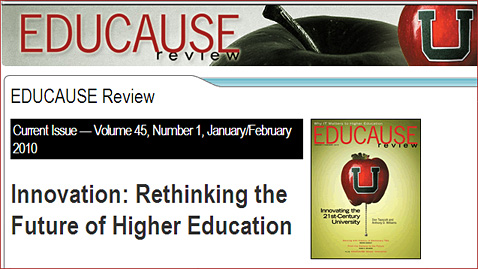Innovation: Rethinking the Future of Higher Education — from Educause Review
From DSC:
There’s that word again…innovation.
This issue of the Educause Review includes an article by Diana Oblinger, whom I quote below. The excerpt in my email said this:
Although the purpose of higher education has not changed in centuries, information technology—with its drive for innovation and entrepreneurism—has increased the options for widening that purpose from the campus of today to the future of society worldwide.
…and in the article, it mentions:
Consider a few changes already evident:
- Formal, traditional boundaries are becoming more permeable and porous. Interdisciplinary fields (e.g., nanotechnology, bioethics) are increasing. Leading faculty are being recruited worldwide. The physical constraints on when and where students participate in education are being removed through open and online education and competency- or experience-based credentialing.
- The classroom is no longer limited to a three-dimensional space for the dissemination of knowledge. Students have virtually limitless access to information, faculty, tutors, and each other. Digital libraries and repositories make materials instantly accessible. And learning is increasingly facilitated by exploration, interaction, and problem-solving. Thanks to large datasets and collections, students at small or remote campuses have access to large-scale resources.
- The library is not defined as a building for books. Many disciplines rely almost exclusively on online resources — whether books, journals, data, or artifacts. Students may consider the library more as a social place than a site for the reference desk or physical books. In addition, the size of library collections becomes less critical in an era when Google and other large-scale digitization projects make it possible for any institution to have access to millions of books.
- The digital environment is a “place” for social interaction and community exchange. Although the value of the campus as a physical place continues, an increasing number of interactions for students, faculty, and staff happen online, including the emergence of virtual, multinational research organizations.
- Scholarship and research are becoming more “conversational.” There is less reliance on communication through formal publications as an increasing number of exchanges occur through e-mail, preprints, and monitored blogs. The journal article may continue to serve as a means of credentialing authors for the purposes of promotion and tenure, but scholars’ contributions to a field are likely to be posted elsewhere.
- Digital technology and the unprecedented scale of data, as well as the nearly limitless ability to reconstitute the data, have altered the conduct of traditional research and scholarship. Theory and experimentation have been augmented with computation involving modeling, simulations, and visualization.
- The more traditional model of a university or college providing most of its services physically on (or near) a campus is changing. More and more services and programs originate off-site and are shared, distributed, or aggregated by other colleges and universities or outsourced agencies.1









